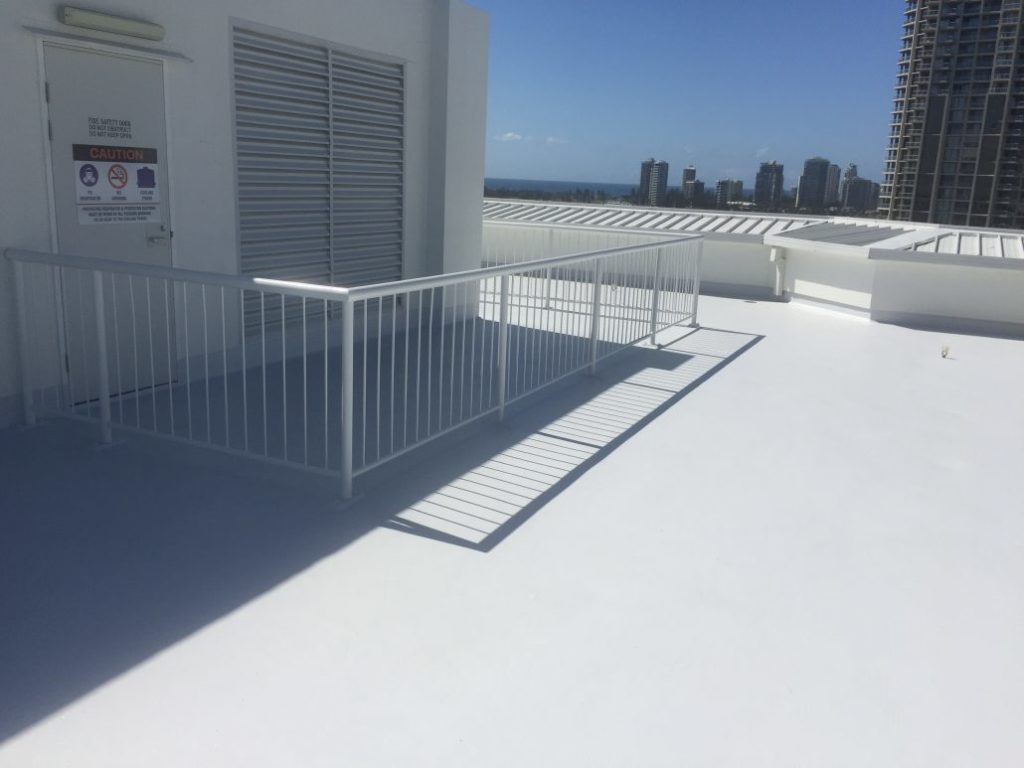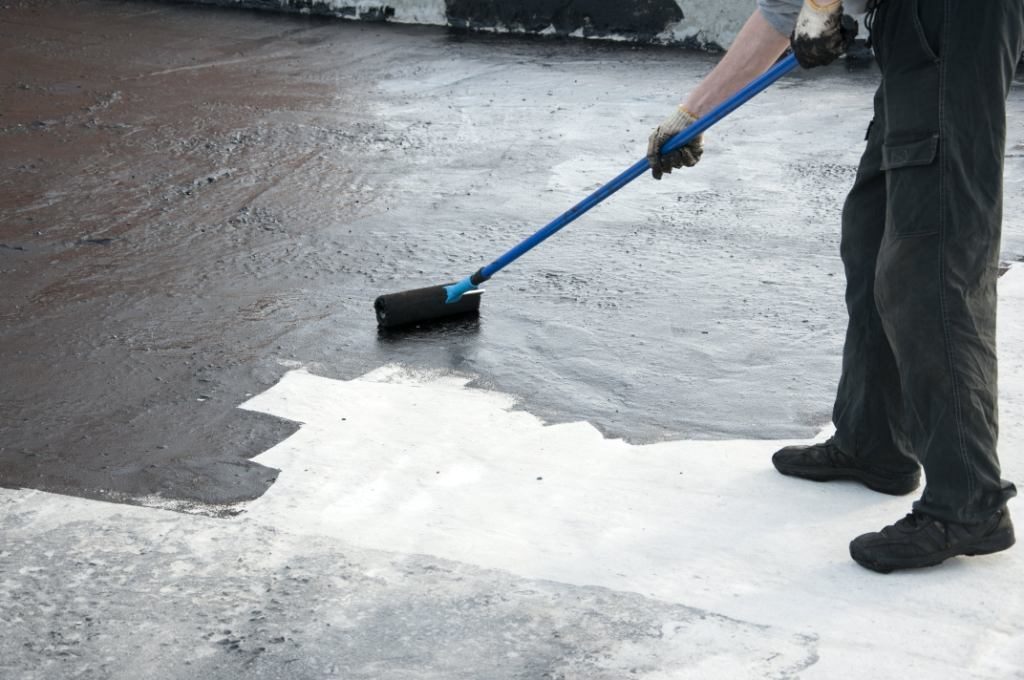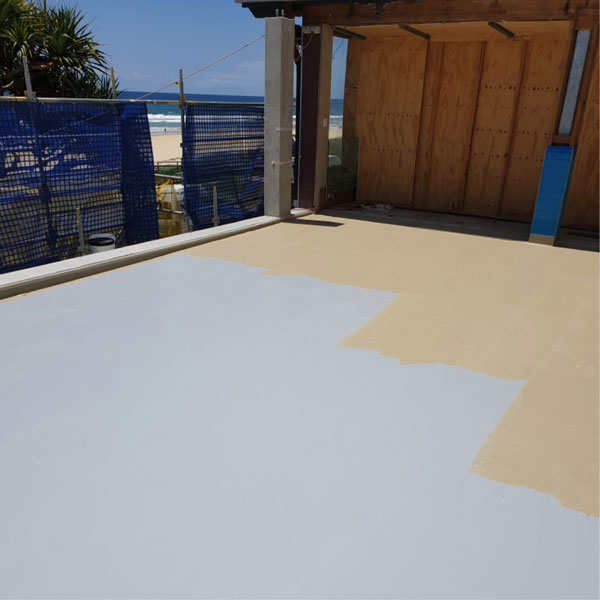Waterproofing is basically a process designed to prevent water from penetrating into a structure. Typically waterproofing is done in various layers and stages to create multiple barriers so that water cannot penetrate the structure. A structure is waterproofed by the use of membranes and coatings to protect contents underneath or within as well as protecting structural integrity. A combination of such stages is referred to as creating a “Building Envelope”. Therefore, compatibility of materials, their interactions, connections of building enclosures altogether also judges the performance of a building. And this performance is most hampered by the outdoor weathering factors, of which rain water and site drainage plays the major role. Thus, protection from weather, seepages from ground and vertical travel of water in a structure can be well protected by the correct application of waterproofing system.
Modern waterproofing systems deal with sustainable architecture by a dual course of action on its application to the source. Various and specific coats with certain proportions of chemicals allows the process to multitask, with ease. The parallel effect of energy conservation occurs because of the use of materials involved in the process. This largely includes the coats on the external walls and floors, which cuts down the heat flow into the building thereby reducing the load on improving the indoor air quality and air conditioning of a space. Waterproofing systems can also be stated as “structural protection and rehabilitation’ or “renewable engineering”, because of its multi-action ability and importance. Waterproofing is not only a major part of procedure of building construction but also hold the dignity in grading a site. (Grading here refers broadly to identification, control and improving the land for proper construction). Therefore, a waterproofing system is technically applicable not only to the building envelope as a whole, but also on the specific parts of a structure.
- FACTORS AFFECTING A BUILDING
Every building can be referred to as a living thing as it also addresses the problems of deterioration if proper care is not taken and maintenance is not involved. In this way, some natural factors like air, water, climate, wind and humidity govern the life of building, apart from the occupancy load. Water (through humidity and rains) is the prime source of degrading or harming a structure, right from its foundation to its plaster if the structure is not well protected from it. Water through its capillary action enters and hampers the strength of concrete, thereby making it susceptible to corrosion. This is observed in building through the development of cracks on plaster, rot formation on walls and presence of moisture on ceiling.
2. PROBLEMS IN A BUILDING
- Natural factors
- Fire
- Water
- Wind
- Earthquakes
- Unnatural factors
- Theft
- Demolishment
- Structural failure
- Other anti-social acts.
3. CLASSIFICATION OF WEATHERING OF A BUILDING ACCORDING TO RURAL AND URBAN AREAS.
- Rural Areas
Rural areas being uniform, monotonous and less exploited in terms of use of varied materials, typical problems may occur confining to the specific construction styles, natural problems of the region. (e.g.: droughts, floods). Use of natural and locally available materials makes it a very typical and finite job to fix the weathering of a structure. The workmanship is dealt at a grass root level to cure any problems if occur.
- Urban Areas
Urbanised areas occur in pockets, cloisters and fragments. Changing of macro climate, excess pollution, over-exploitation of land, lack of green spaces, excess use of greenhouse gases, roads are the major causes of weathering in urban areas. These causes the material to withstand high temperature differences as a result it weathers, undergoes major changes in its composition and develops cracks. However, mostly the construction style, material and methods are similar and thus easy to check and cure.
- WATERPROOFING – THE PROCESS
Of all the points mentioned above, the commonly addresses problems are confined to water. Water through various sources and in any form harms the structure. This happens in the form of the following:- Ø
- Seepages through walls, sills, lintels, claddings, extensions, beam-brickwork joint.


- Capillary rise through foundation, external wall, common walls, exterior wall-floor joints, columns, Chejja.
- Up thrust action and buoyancy in contours against retaining wall, under reinforced basement flooring and underground basement spaces.
Avoiding these problems can never be a good idea for a designer as it would destroy and deteriorate the design, be it an interior or the exterior. Therefore, waterproofing as a process, precaution and cure is taken to overcome these problems, subjected to specific areas and required materials.
4.1 SOLUTION- WATERPROOFING
It is the restriction of water (capillaries, vapours, moisture) from entering into a structure, through formation of various layers around the structure. It is done in a way, keeping the breathing property of the building alive and screening the excess gaps, holes and leakages.
4.2 IMPORTANCE OF WATERPROOFING
Building waterproofing is a process which is designed to prevent water from penetrating a building. Usually extensive waterproofing measures are added to a building at the time of construction, to provide moisture control from the start, and waterproofing may also be done after a building is built, to address problems as they emerge or as part of a building retrofit.
Waterproofing is critical, for a number of reasons, and many contractors around the world specialize in building waterproofing, providing maintenance, restoration, and new construction services. From the point of view of its occupants, building waterproofing is important because
- It keeps a building dry.
- It also reduces internal humidity, making a building more comfortable to work in and protecting objects inside the building from damage as a result of humidity and water vapour.
- Building waterproofing is also important to the integrity of the building itself.
Typically, building waterproofing is done in several different ways to create multiple barriers for water so that it cannot enter a structure. Together, waterproofing measures are known as “the envelope.” Some signs that there is a problem with the building waterproofing include:
- wet basement walls
- the proliferation of Mold and fungi
- signs of rot
- Pooling water inside a structure.
- DIFFERENCE BETWEEN WATER RESISTANT AND WATER PROOF MATERIAL
Water-resistant and waterproof refer to THE AMOUNT OF WATER THAT IS PREVENTED FROM ENTERING OR EXITING AN ITEM. Despite having the same purpose, these terms are different and should not be used synonymously. The main difference between water-resistant and waterproof is that water RESISTANT PRODUCTS CAN WITHSTAND WET WEATHER BUT CANNOT WITHSTAND BEING TOTALLY SUBMERGED IN WATER; WATERPROOF PRODUCTS CAN.
Levels of protection for which a product resists the entry of water can vary. Each water-resistant and waterproof product is GIVEN A LEVEL RATING FROM THE IP RATING SYSTEM, WHICH RATES THE INGRESS PROTECTION OF THE PRODUCT. This is an important factor for consumers to pay attention to when purchasing water-resistant and waterproof products, particularly an electronic, such as a watch. The ratings range from level 0, meaning that not even a drop of water should touch the item, to level 8, meaning that item could go to the bottom of a large body of water and still function correctly.

- PROCESS OF WATERPROOFING
Waterproofing is done in layers, above the structure, retaining the breathing property of it, to avoid seepage and capillary rise of water into it. Internally in repels the water content present in structure and externally it forms a protective film around itself. Typically, building waterproofing system is done by creating multiple barriers for stopping the inflow of water, so that it cannot enter the structure. This development of multiple layers, by the materials and techniques in it creates an “envelope” kind of structure around the building. This envelope can be treated as a sustainable feature or a green building measure by avoiding the inflow of excess heat from atmosphere. This can be done by the application of various paints, coatings and other material finishes and cladding which help creating a transition between the outdoor and indoor temperature. This transition between the temperatures helps the structure in following ways:
- The minimum difference between the indoor and outdoor temperature of a building causes less signs of weathering and safeguards the structure. This happens in a way that the effect of contraction or expansion during various seasons in the material composition of building is reduced, by matching or equalising the room temperature and outdoor temperature.
- Reduces the load on the HVAC system, and other processes that a building occupant tends to use for making the room temperature habitable. This reduction can be well counted in savings of electricity consumption, potable water consumption and other resources consumption. This tends to take the building towards a greener environment.
- TYPES OF WATERPROOFING METHODS
There are some common types of waterproofing methods used in construction industry. Waterproofing in buildings/structures is generally required for:
- Basement of structure
- Walls
- Bathrooms and kitchen
- Balconies, decks
- Terrace or roofs
- Green roofs
- Water tanks
- Swimming pools
The following waterproofing methods are commonly used in construction:
- Cementitious Waterproofing
- Liquid Waterproofing Membrane
- Bituminous Membrane
- Bituminous Coating
- Polyurethane Liquid Membrane
- CEMENTITIOUS WATERPROOFING METHOD:
Cementitious waterproofing is the easiest method of waterproofing in construction. The materials for cementitious waterproofing are easily available from suppliers of masonry products, and they’re easy to mix and apply.

This method is often used in the internal wet areas such as toilets. This method is usually a rigid or semi-flexible type waterproofing, but since it is used in internal areas such as toilets, it is not exposed to sunlight and weathering. Thus cementitious waterproofing does not go through contract and expansion process.
APPLICATIONS OF CEMENTITIOUS WATERPROOFING:
Cementitious waterproofing is used in the following type of structures:
- Water Treatment Plants
- Sewage Treatment Plants
- Bridges
- Dams
- Railway & Subway Systems
- Marine Cargo Ports & Docks
- River Locks/Channels & Concrete Dykes
- Parking Structures & Lots
- Tunnels
- LIQUID WATERPROOFING MEMBRANE METHOD:
Liquid membrane is a thin coating which consists of usually a primer coat and two coats of top coats which are applied by spray, roller, or trowel. It offers more flexibility than the cementitious types of waterproofing. The liquid cures into a rubbery coating on the wall. The elongation properties of the coating can reach as high as 280%. The durability of the waterproofing coating depends on what type of polymer the manufacturer use for the making of the liquid waterproofing.

Liquid waterproofing membrane can be of spray-applied liquid membrane composed of polymer-modified asphalt. Polyurethane liquid membranes in separate grades for trowel, roller, or spray are also available from various manufacturers.
- BITUMINOUS COATING WATERPROOFING METHOD:
Bituminous coating is a type of coating used for waterproofing and flexible protective coat in accordance with its formulation and polymerization grade. Its flexibility and protection against water can be influenced by the polymer grade as well as reinforcement of fibre.

Bituminous coating is also called as asphalt coating. The most common applications of bituminous coatings include areas that are beneath screed wet. It is an excellent protective coating and waterproofing agent, especially on surfaces such as concrete foundations. Bituminous coating is made of bitumen based materials and it is not suitable for expose to sunlight. It becomes very brittle and fragile when long exposure to the sunlight unless it is modified with more flexible material such as polyurethane or acrylic based polymers. The flexibility of the finished products always depends on the solid content of the polymer added to the bitumen.
BITUMINOUS MEMBRANE WATERPROOFING METHOD:
Bituminous membrane waterproofing is a popular method used for low-sloped roofs due to their proven performance. Bituminous waterproofing membrane have torch on membrane and self-adhesive membrane.
Self-adhesive compounds comprise asphalt, polymers and filler; additionally, certain resins and oils may be added to improve adhesion characteristics. The self-adhesive type has low shelf life as bonding properties of the membrane reduces with time.
Torch on membrane have exposed and covered types. Exposed membrane often has mineral granular aggregate to withstand the wear and tear of the weathering and the other types of membrane, contractor need to apply one protective screed to prevent the puncture of the membrane.

- POLYURETHANE LIQUID MEMBRANE WATERPROOFING METHOD:
Polyurethane liquid membrane method of waterproofing is used for the flat roof area and exposed to weathering. This waterproofing method is expensive.

Polyurethane Liquid Membrane can offer higher flexibility. Polyurethane is very sensitive to moisture content present, therefore before application, one has to be very careful evaluating the moisture content of the concrete slab, otherwise peeling or de-bonding of membranes may happen after some time.
CONCLUSION
Water damage can be a serious issue in a structure. With water come moulds and a host of other problems which can undermine foundations, make conditions in the building unsafe, and damage property inside the building. Wooden buildings can suffer rapid decay from water exposure, but water penetration can also damage concrete and other building materials, especially in cold climates where water may freeze and cause cracks. Insufficient waterproofing can be a problem year round, not just during the rainy season. Some permeability in a building is desired, not least because building occupants generate humidity which must be safely vented. The goal of building waterproofing is to prevent as much water as possible from entering the building, and to provide outlets and drainage so that if water does get inside, it is not allowed to sit.




